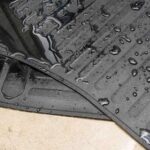It’s an unsettling experience: you’re driving down the road, and suddenly, your car starts to tremble. That shaking steering wheel or vibrating seat can quickly turn a comfortable drive into a stressful situation. Nobody wants to be stranded on the roadside, far from a reliable auto repair shop. Often, these breakdowns can be avoided with consistent vehicle maintenance. While wear and tear on car parts is inevitable, neglecting routine checks can lead to much larger, more expensive problems down the line. At cars.edu.vn, we believe in proactive car care. Our expert technicians are dedicated to diagnosing issues early and creating personalized maintenance schedules to keep you on the road.
One of the most frequent concerns drivers face is car trembling or shaking. This vibration can occur at various times – while accelerating, braking, or even idling – and understanding the root causes is the first step to resolving it. Let’s explore the top reasons why your car might be trembling.
Top Reasons Your Car May Be Trembling
1. Engine Performance Issues
The heart of your vehicle, the engine, is a complex system with many interconnected parts. Several engine components can cause your car to tremble if they aren’t functioning correctly. Two common culprits are spark plugs and the engine air filter.
Spark Plugs: Spark plugs ignite the air-fuel mixture in your engine’s cylinders, creating the combustion that powers your car. If spark plugs are old, fouled, or improperly connected, they can misfire, leading to uneven engine operation and vibrations. As a general guideline, spark plugs typically last between 80,000 and 100,000 miles, but this can vary depending on your vehicle’s make and model. Regularly inspect your spark plugs and their connections.
Engine Air Filter: Your engine needs clean air to burn fuel efficiently. The engine air filter prevents dirt, dust, and debris from entering the engine. A clogged or dirty air filter restricts airflow, starving the engine of oxygen and disrupting the fuel-air mixture. This can result in rough idling, reduced engine power, and, yes, trembling. Replacing your engine air filter is a simple and relatively inexpensive maintenance task that can significantly improve engine performance and prevent trembling.
2. Brake System Problems
If you notice the trembling primarily when you apply the brakes, the issue is likely related to your car’s brake system, particularly the front brakes. Front brakes handle the majority of the stopping force, making them more susceptible to wear and tear.
Brake Rotors: Brake rotors are the shiny metal discs that the wheels are attached to. When you apply the brakes, the brake pads clamp down on these rotors to slow your car. Over time, rotors can warp or become uneven due to heat and friction from repeated braking. Warped rotors cause the brake pads to grab unevenly, resulting in vibrations that you feel through the steering wheel and brake pedal, especially during braking.
Brake Pads: Brake pads are the friction material that presses against the rotors. They have a limited lifespan and wear down with use. Worn brake pads can cause vibrations, squealing noises, and reduced braking efficiency. If your brake pads are worn thin, the metal backing plate can even make contact with the rotor, causing damage and significant vibrations. While brake replacement intervals vary, a general guideline is around 50,000 miles. However, factors like driving habits and vehicle type can affect brake pad life. Regular visual inspections of brake pad thickness during oil changes are crucial.
Brake Calipers: Calipers are components that house the brake pads and apply pressure to them against the rotors. A malfunctioning caliper, such as one that is sticking or seizing, can cause uneven brake pad wear and vibrations. A stuck caliper can also overheat the brake rotor, potentially warping it and exacerbating the trembling issue.
3. Axle and Drivetrain Concerns
Your car’s axles are essential components that transfer power from the engine and transmission to the wheels. Most cars have two main axles – one for the front wheels and one for the rear wheels.
Bent or Damaged Axles: If an axle becomes bent, often due to hitting a curb, pothole, or being involved in an accident, it can cause significant vibrations, especially during acceleration. As the bent axle rotates, it creates an imbalance, leading to increased trembling as your speed increases.
CV Joints and Driveshaft: Constant Velocity (CV) joints are flexible couplings that allow the axles to transmit power smoothly even when the suspension moves and the wheels turn. The driveshaft is a rotating component that transmits power to the wheels, particularly in rear-wheel-drive and four-wheel-drive vehicles. Worn or damaged CV joints can allow dirt and debris to enter, leading to joint failure and vibrations, especially during turns or acceleration. A damaged driveshaft can also cause significant vibrations, particularly at higher speeds.
4. Wheel Imbalance and Alignment Issues
Problems related to your wheels themselves can also be a source of car trembling.
Wheel Imbalance: Even perfectly round wheels and tires can have slight weight imbalances. These imbalances become more noticeable at higher speeds, causing vibrations that you can feel through the steering wheel and seat. Wheel balancing involves adding small weights to specific points on the wheel to counteract these imbalances and ensure smooth rotation.
Wheel Bearings, Tie Rod Ends, and Ball Joints: These are crucial components of your car’s suspension and steering systems. Worn wheel bearings can cause wheel wobble and vibrations, often accompanied by a humming or grinding noise. Loose tie rod ends or ball joints can also lead to steering wheel shaking and vibrations, as they affect wheel stability and alignment.
5. Tire Problems
Your tires are the only point of contact between your car and the road, so tire-related issues are often a cause of vibrations.
Tire Imbalance: Similar to wheel imbalance, tires themselves can also have slight weight variations. Tire balancing is essential for smooth, vibration-free driving.
Uneven Tire Wear: If your tires are wearing unevenly – perhaps more on the inside or outside edge, or showing signs of cupping or scalloping – it can create vibrations. Uneven wear can be caused by improper tire inflation, misalignment, or suspension problems.
Tire Rotation: Regular tire rotation helps to ensure even wear and extend tire life. Rotating your tires at recommended intervals can prevent uneven wear patterns that lead to vibrations.
Tire Condition: In some cases, the tires themselves may be the source of the problem. Old, damaged, or improperly inflated tires can cause vibrations. Sidewall bulges, tread separation, or flat spots can all lead to car trembling. Sometimes, the solution is simply replacing worn or damaged tires.
Preventative Maintenance is Key
Regardless of the specific cause of your car’s trembling, addressing it promptly is crucial. Ignoring these vibrations can lead to further damage and more costly repairs down the road. The best way to prevent car trembling and other automotive issues is through regular vehicle maintenance.
At our dealership, cars.edu.vn, our team of certified professionals is ready to thoroughly inspect your vehicle, diagnose the cause of any trembling, and provide expert repairs. We also create customized maintenance schedules tailored to your car’s make and model. Following a regular maintenance plan is the best way to ensure a smooth, safe, and comfortable driving experience, and to avoid the unsettling experience of a trembling car. Schedule your service appointment today and let us help you keep your car running smoothly for years to come.

